| |
10 strikes, and you’re out at Louisville Slugger Museum
By Tom Adkinson
September 3, 2021
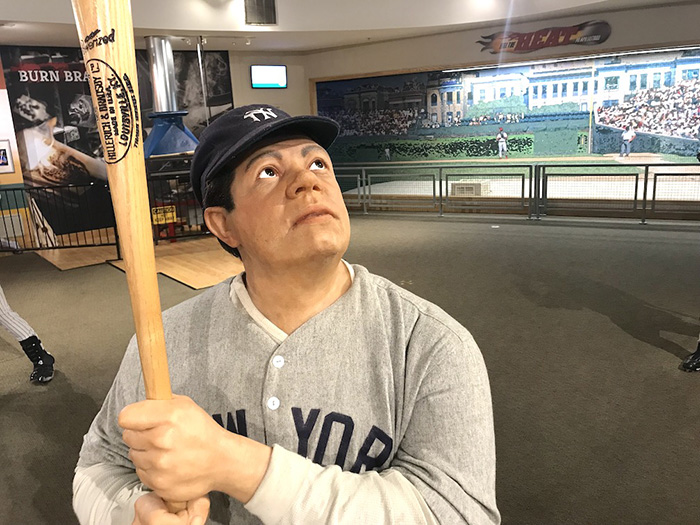
New York Yankee legend Babe Ruth looks to the sky, following another home run. Image by Tom Adkinson |
LOUISVILLE, Kentucky – You don’t have to know who won last year’s World Series, understand the infield fly rule or even know the distance between bases on a baseball diamond to thoroughly enjoy the Louisville Slugger Museum and Factory.
About all you need to know is that baseball involves a ball and an implement with which to hit it.
When you take the tour – which winds right through the heart of the manufacturing process – you quickly learn that all bats are not created equal. Not by a long shot. At a certain level of play, a baseball player wants the right tool of the trade in order to keep earning his multi-million dollar salary.
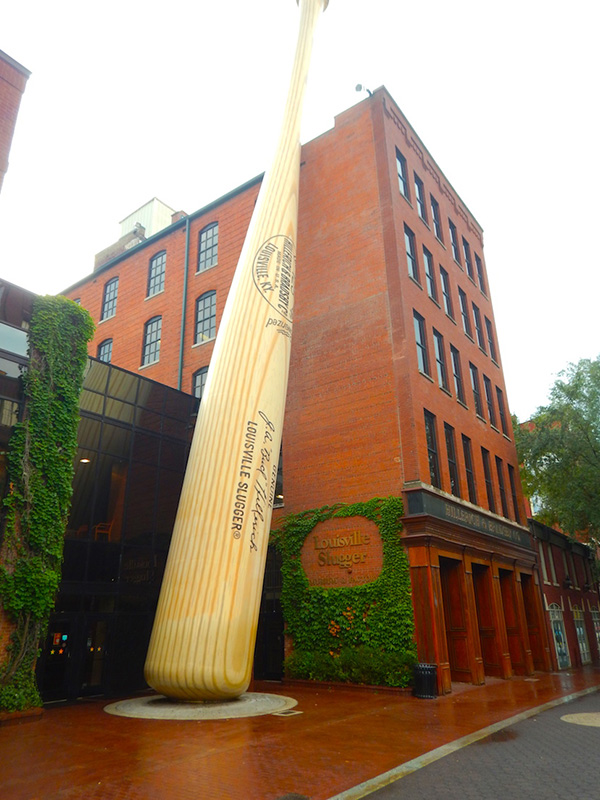
The 120-foot-tall bat outside the Louisville Slugger Museum and Factory is a landmark in downtown Louisville. Image by Tom Adkinson |
Finding the museum and factory is easy. It’s the only building in downtown Louisville – or anyplace else – with a 120-foot-tall baseball bat sculpture at its front door. It’s an exact-scale replica of Babe Ruth’s 34-inch Louisville Slugger bat. It is steel, of course, instead of wood, and it weighs 34 tons.
Inside the building is another oversized piece of baseball art. It is a baseball glove cradling a baseball that is carved from a 17-ton piece of Kentucky limestone. There’s enough room left inside the glove for two or three youngsters to climb in next to the baseball.
Your visit begins in a museum space dotted with several life-size statues of famous players, all wielding Louisville Slugger bats. If you want, you can stand right beside Babe Ruth, Jackie Robinson, Ken Griffey Jr. and other legends for a keepsake photo.
The company behind the famous bats is Hillerich & Bradsby, and your tour guide briefly touches on its history.
German immigrant J. Frederick Hillerich arrived in Louisville in 1856 and opened a woodworking business, but baseball bats weren’t in the picture. The company made spindles, shutters, steamboat interiors and a patented swinging butter churn. J. Fred saw a great future in butter churns and was cool to the idea of making baseball bats, which his son Bud brought to the plate.
Company legend says Bud made the first professional bat for Pete Browning in 1884. Browning was a star on a Louisville baseball team called the Eclipse, and the legend says Browning got three hits with Bud’s bat in the next game.
Almost no one remembers Pete Browning, but they do remember his nickname: The Louisville Slugger.
Before getting to the factory floor, the tour stops in a room with a video projection screen the size of a Jumbotron at a baseball stadium. The first image is a beautiful forest, the spot in Pennsylvania where all Louisville Slugger bats are born as ash, maple or birch trees.
A tree that’s ready for the trip to Louisville is straight, healthy and about 65 feet tall. Hidden inside it are about 60 bats.
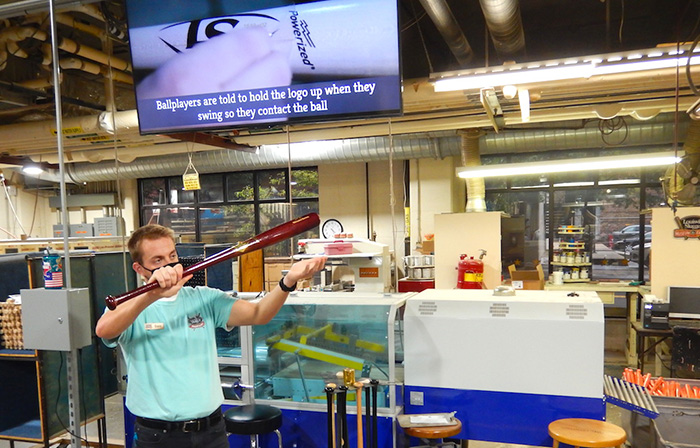
On the noisy Louisville Slugger factory floor, monitors with rolling scripts supplement tour guides’ presentations. Image by Tom Adkinson |
Factories are noisy places, of course, and the Louisville Slugger tour overcomes that challenge with well-planned stops to see machinery in action, listen to the tour guide and then have video monitors with informative clips and scripts that reinforce what you are seeing and hearing.
Making a bat is more complex and exacting than you might imagine. Major League Baseball players with ties to the company are quite precise about size, weight, grip and other factors for their bats. Some come to the factory to select the pieces of wood (they’re called billets) that will become their bats. Hall of Famer Ted Williams famously did that.
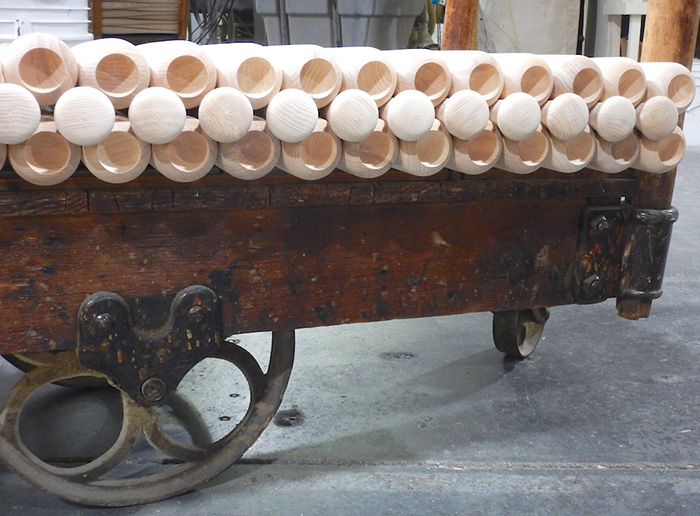
A sturdy cart with decades of use holds dozens of bats prior to the next stop on the production line. Image by Tom Adkinson |
Once a season, the tour guide says, players who swing Louisville Sluggers play with pink bats. It is a Mother’s Day initiative called “Going To Bat Against Breast Cancer” that has raised more than $1 million for cancer research since 2006.
Interesting insights into American history are sprinkled through the museum and factory tour. Among them:
• Hillerich & Bradsby signed a bat contract with Jackie Robinson six months before he broke baseball’s color barrier.
• Hank Aaron donated the bat he used to hit his 700th home run. It is displayed with a death threat he received as he pursued Babe Ruth’s home run record.
• A major display tells the story of the Louisville Unions, a Black team that whipped all comers long before the Negro Leagues were formed. A newspaper clip promoting a game with a white team notes, “There will be special grandstand seats for white people.”
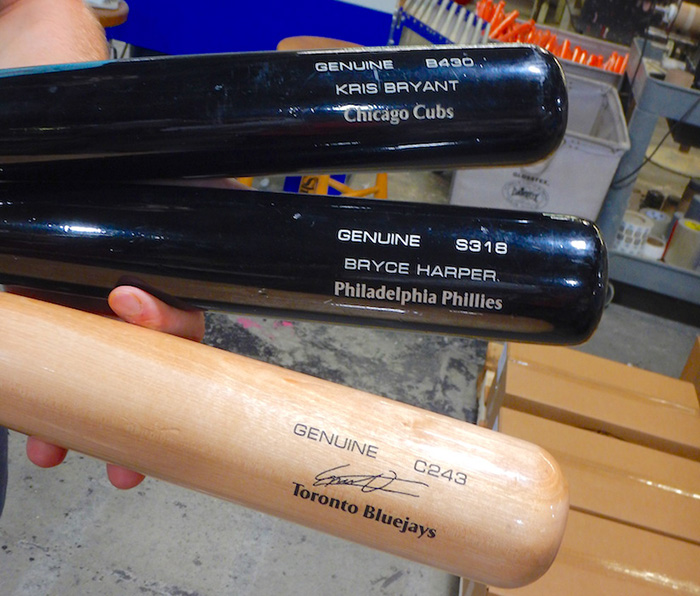
Louisville Slugger craftsmen have a multi-step process to get players’ names on their custom-made bats. Image by Tom Adkinson |
At the end of every tour, you get a miniature Louisville Slugger bat as a memento. I chose one with Roberto Clemente’s signature, and that inspired me to plunk down $2 for 10 swings in Bud’s Batting Cage, named for the maker of the first Louisville Slugger.
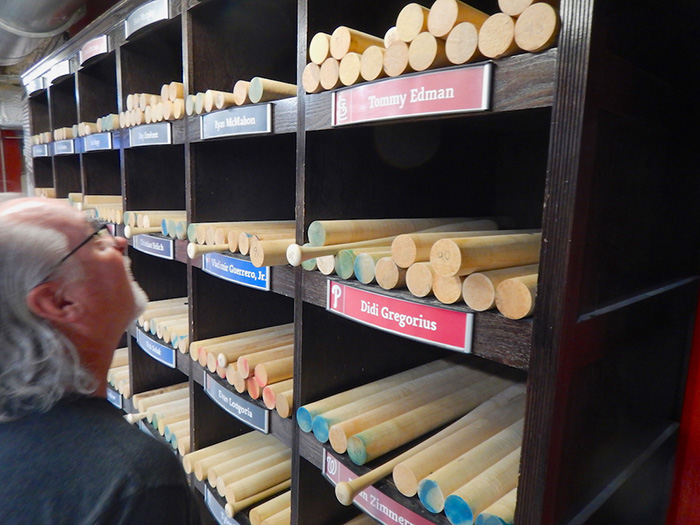
A Louisville Slugger tour guest examines a big display of bats ready to be made for specific MLB players. Image by Tom Adkinson |
I chose a bat, donned a batting helmet and entered the cage after the attendant said the pitches would be in the strike zone and at only about 45 or 50 miles an hour. The pitches came quickly.
It’s a humbling experience when a spectator shouts, “Ten strikes and you’re out!”
|

